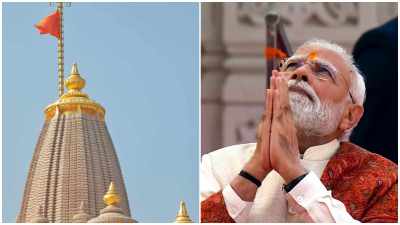Flanked by debris of razed homes, life goes on as usual at this migrant settlement spared in Chandola lake demolitions
Narsinhji Mandir Ni Chali is situated in Chandola lake area where more than 12,500 residential, commercial and religious structures, which were allegedly encroaching upon the water body, were razed in May
 This chali, a small peninsula jutting into a dried up area of the lake, was spared. Reason: This piece of land appeared in AMC's records as a private survey number, attesting its legal status (Express Photo)
This chali, a small peninsula jutting into a dried up area of the lake, was spared. Reason: This piece of land appeared in AMC's records as a private survey number, attesting its legal status (Express Photo)It is 4.30pm. Shivlal, who goes by only one name, is manning his handcart that doubles up as a paan stall at the gates of Narsinhji Mandir Ni Chali in Ahmedabad. Inside, the modest housing society is milling about with people. There are stalls selling pani-puri and pakodas, autorickshaws parked, women washing clothes on slabs outside their homes, men standing in groups of three or four, chatting away in the afternoon.
It may seem like a scene from any other locality but the moment one steps outside the gates of this settlement, a starkly different world opens up: Acres and acres of empty land, debris of what once used to be homes of thousands, children playing a game of cricket on a small patch.
Narsinhji Mandir Ni Chali (or Society of the Narsinhji Temple) is situated in Chandola lake – the same area that witnessed large-scale demolitions in May when the Ahmedabad Municipal Corporation (AMC) and the city police razed more than 12,500 residential, commercial and religious structures that were allegedly encroaching upon 4 lakh square metres of the total 11 lakh square metres area of the water body.
 Recalling the days of the demolition, Durga Prasad from Chitrakoot in Uttar Pradesh told The Indian Express, “We were scared when the demolitions began” (Express Photo)
Recalling the days of the demolition, Durga Prasad from Chitrakoot in Uttar Pradesh told The Indian Express, “We were scared when the demolitions began” (Express Photo)
This chali, a small peninsula jutting into a dried up area of the lake, was spared. Reason: This piece of land appeared in AMC’s records as a private survey number, attesting its legal status.
Home to migrants from Uttar Pradesh
Recalling the days of the demolition, Durga Prasad from Chitrakoot in Uttar Pradesh told The Indian Express, “We were scared when the demolitions began… They (AMC) reached our chali within 30 minutes of arriving here. Fortunately, the officials knew that this is private property. It was only after they went ahead that we heaved a sigh of relief.”
The chali is home to around 550 migrant workers from the Hindi heartland of UP, who have settled here over the years. “Everyone who stays here is from UP. I have been living here for the last 35 years,” says Durga Prasad, a resident.
Barely a few metres from the chali, a man is seen lying on a cot, covered with a worn-out blanket, wheezing and coughing in his sleep. His wife sits under a makeshift awning made up of parts of billboards while a toddler struts about. This family was among the thousands who were evicted in May.
The woman told The Indian Express, “My husband, who used to work as a labourer, hasn’t been able to do anything after being diagnosed with TB. We have four daughters and our relatives were kind enough to take them into their homes but we cannot go and live there. So, we came back here. Some people come and give us food. We have nowhere to go.”
 A couple of other temples also dot the premises, including one dedicated to Lord Shiva, another to Lord Hanuman and one to Lord Padmanabha (Express Photo)
A couple of other temples also dot the premises, including one dedicated to Lord Shiva, another to Lord Hanuman and one to Lord Padmanabha (Express Photo)
Inside the chali, its gates bearing the name of the local MLA and two councillors, there are around 70 houses, mostly occupied by young men selling pani-puri or paan, driving auto-rickshaws, or working as drivers on hire for taxi companies. Yellow fences erected by the civic body have come up on both sides of this gate, parting it from the razed walls, destroyed doors and torn shutters of shops strewn all around.
The former occupants of this area claimed they had been living there for decades before Chandola lake came into focus in the Pahalgam attack aftermath – first when hundreds were picked on suspicion of being illegal migrants from Bangladesh and then, when the anti-encroachment drive was carried out in two phases. The area is now being fenced up for the “Chandola Lakefront development project”.
Inside the chali, the most prominent structure is a colourful temple dedicated to Narsinhji from where the society derives its name.
Trustees claim this temple is more than 100 years old. A stone inscription dates it to Samvat 1951, which would translate to 1859 CE on the Gregorian Calendar.
A couple of other temples also dot the premises, including one dedicated to Lord Shiva, another to Lord Hanuman and one to Lord Padmanabha. Another temple belongs to the Kuldev (clan deity) of the trustees, who are from the Prajapati community.
Opposite the main temple is an underground cave that, according to the residents, used to be the home of the presiding priest (pandit) of the temple in the past. The present priest, though, lives in a pucca house next to the temple. Another striking structure here is a white tower, approximately two stories tall, which looks like it has seen better days.
When asked why this society was not demolished, sources at the AMC said, “When we were carrying out the demolitions, our attention was drawn to the fact that this piece of land is a private survey number. The same was seen in documents from the Ahmedabad Collectorate when they handed us possession of the land in and around Chandola lake.”
 The Indian Express also reached out to the Ahmedabad Collectorate regarding the ownership of the land but did not receive any response at the time of going to print (Express Photo)
The Indian Express also reached out to the Ahmedabad Collectorate regarding the ownership of the land but did not receive any response at the time of going to print (Express Photo)
A senior AMC official involved in the demolition process, though, said he “was shocked that this land occupied by so many houses and temples and jutting into the lake bed, was classified as private property.”
Deputy Municipal Commissioner of the South Zone, BC Parmar, told The Indian Express: “Narsinhji Mandir Ni Chali with the temple inside is registered as private property in the TP (town planning) scheme, which we received from the Collectorate. We are looking into the current ownership of the land.”
The Indian Express also reached out to the Ahmedabad Collectorate regarding the ownership of the land but did not receive any response at the time of going to print.
Chetan Swami, one of the trustees of the Narshinhji temple, claimed the temple has been with his family for generations.
“The temple and land is passed down from generation to generation to the eldest brother in the family. The current head of the trust is my brother Harshad K Swami. We are four brothers and all are trustees. In fact, I am also a trustee of the Narsinhji temple in Patan district,” said Swami, who lives in another part of the city and owns an automotive spare parts shop. He says he visits the chali everyday to pay obeisance to the deity.
The residents of this locality pay a modest rent of Rs 50-Rs 80, which is used in renovation and repair of the temple.
Tale of two festivals
When asked how the temple premises turned into a residential colony, Swami said, “Around 50 years ago, the entire area was open. But after the riots that time, people who used to stay here as caretakers of the temple started feeling unsafe and brought over their UP-based relatives to stay and work here. Slowly, the community grew. In fact, there is an annual festival celebrated here where devotees from Bhanderi Pol arrive with a palki on Kartik Sood Chaudas.”
 The chali is home to around 550 migrant workers from the Hindi heartland of UP, who have settled here over the years (Express Photo)
The chali is home to around 550 migrant workers from the Hindi heartland of UP, who have settled here over the years (Express Photo)
Another festival was marked a few days ago, not very far from this chali. A number of families of the Devipujak community, who lived about 2 km from the chali, had returned to the site of their demolished homes to install statues of the deity Dashama for her 10-day rituals of fasting and prayer. They immersed the statues in the Sabarmati river on Sunday before going back to their rented accommodations.
As the pani-puri vendors from the chali prepared to leave for another evening of business, a 60-year-old, Abdullah Muttalim, sat in the back seat of a weathered auto-rickshaw with a bag full of tobacco products and cigarettes. Having lost his home and shop during the demolitions, Muttalim now lives at his son’s rented home in the Vatva area of the city. In an attempt to contribute to the household income, he has returned to the site of his demolished shop where his loyal customers instantly recognised him.
“I came here from Khambhat (Anand) when I was only a boy. My father fled in wake of the wave of Tuberculosis and Silicosis that affected Akik (jade) workers there. I grew up here but now that my shop is gone, I come here and sit in the hope that my old customers will still buy from me. It is my way of putting some money into the household,” said Muttalim.
There is another reason. “My son has filled out the form to get us alternate housing that the AMC has been offering to the evictees. We have to pay more than Rs 3 lakh for allotment. So, every penny counts.”







